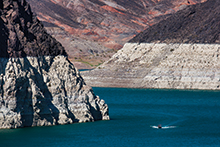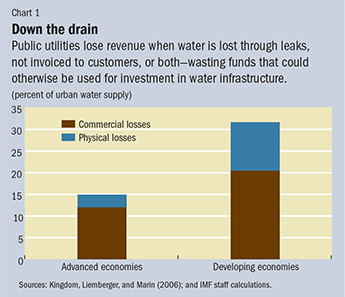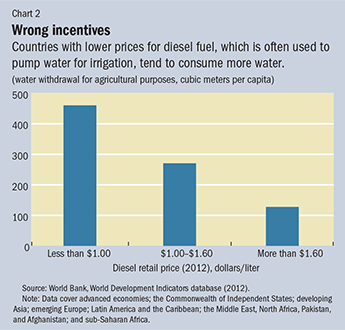Is the Glass Half Empty or Half Full?
Finance & Development, June 2015, Vol. 52, No. 2
Kalpana Kochhar, Catherine Pattillo, and Yan Sun
Getting incentives right can go a long way toward managing water challenges while protecting the poor

We never know the worth of water till the well is dry. — Thomas Fuller
The largest reservoir system serving São Paulo, Brazil, is nearing depletion. A combination of population growth, deforestation, polluted rivers, and the worst drought in southeast Brazil in nearly a century has forced many residents to endure sporadic service interruptions. Some have gone days without water. Residents have resorted to drilling private wells or hoarding water to wash clothes and flush toilets.
Thousands of miles to the north, parts of the United States are also experiencing severe water shortages, driven by decades of unsustainable consumption combined with drought conditions. A “bathtub ring” lines Lake Mead, the largest reservoir in the United States, marking the level water once reached. In April 2015, California state regulators passed significant mandatory cuts to water use, beyond the already strict limits on watering and landscaping, with heavy fines imposed on violators. Farmers foresee leaving up to 1 million acres of farmland uncultivated, almost twice as much as last year.
The things which have the greatest value in use have frequently little or no value in exchange; on the contrary, those which have the greatest value in exchange have frequently little or no value in use. — Adam Smith
In January 2015, the most devastating floods in living memory ravaged Malawi, a densely populated low-income country whose people survive on subsistence farming. The floods displaced nearly a quarter of a million people and destroyed crops, villages, and livestock. Malawian President Peter Mutharika declared half the country a disaster zone.
These are just some of the water challenges plaguing countries across the globe. People throughout the world face rising constraints on their ability to obtain water in a usable form, when and where it is needed. Globally, 1.2 billion people, or one in six, live in areas with an inadequate water supply, approximately one in nine lacks access to safe drinking water, and every minute a child dies of a water-related disease.
Water challenges can have large adverse economic, social, and environmental consequences. Since water is a crucial input for agriculture and a host of other industries, shortages and supply variability can lead to food insecurity, push up production costs, and constrain productivity growth. For example, water-related shocks may have reduced Mozambique’s GDP growth by as much as 1.1 percentage points a year during 1981–2004, according to the World Bank (2007).
Lack of access to safe drinking water and improved sanitation inhibits development in a variety of other ways too, including by raising the prevalence of disease, worsening health and nutrition outcomes, and lowering the participation of women—who are typically tasked with collecting and hauling water for household use—in education and income-generating activities. Degradation of water can also dry up activity in sectors such as tourism that depend on environmental quality.
But sound policies and institutions have helped even countries with low endowments of water successfully manage this scarce natural resource, according to a new IMF study. Underpricing often leads to overuse and undersupply, the study finds. By setting the right incentives, governments can effectively cope with these challenges and, at the same time, provide for the water needs of the poor.
A thirstier world
A rising tide of demand for water is putting increasing pressure on water resources in many countries. The global stock of freshwater available for human use is limited and unevenly distributed; more than 60 percent of it is found in just 10 countries. On a per capita basis, freshwater available in the Middle East and North Africa region is only a tiny fraction of that in Latin America. Even in countries with an abundant supply of water overall, particular regions could face severe water shortages. And water availability in any given location can also vary significantly throughout the year as a result of interannual climate variation, seasonal variation, droughts, and floods.
As the cases of southeast Brazil and California illustrate, many parts of the world are already experiencing water shortages, and millions of people have difficulty fulfilling their basic water needs. The World Resources Institute found that 36 countries face high water stress, defined as withdrawing more than 40 percent of the annual available supply (Gassert and others, 2013). This level of use can cause shortages in specific localities and result in environmental damage.
Furthermore, the demand for water is set to continue rising with population growth, urbanization, and economic expansion. Although there is some evidence of water use leveling off as countries grow wealthier, long-term scenarios forecast large increases in water use that, for many countries, cannot be met by existing supplies. Technological advances such as desalination and recycling have helped ease water supply constraints in some advanced economies but are expensive and require substantial up-front investment. Climate change and underinvestment in water infrastructure are expected to exacerbate this water demand-supply imbalance.
Assigning a price to water is complicated because of its unique features and the social, environmental, and political considerations surrounding it. Water is a heterogeneous commodity that can be used sequentially; it can be a private good (for example, when purchased in a bottle or delivered to a house via a pipeline) or a public good (for example, accessible to anyone from lakes, rivers, and underground aquifers). Because water is bulky and costly to move, its transport and storage frequently require considerable initial investment and ongoing maintenance costs that can be difficult to accurately reflect in a price charged to users.
In addition, universal access to water has long been viewed as a human right and is a clearly stated global public policy goal; attempts to price water need to be carefully executed to avoid undermining this objective. Moreover, externalities such as the environmental impact of water use and the reduction in availability for other users are hard to capture in water pricing, not least because the amount used—especially of groundwater extracted—is difficult to monitor.
Leaky system
In many countries, water management resembles a system of leaky pipes. Uses with privileged access or favored by regulation sometimes siphon off more than their fair share, leaving uses with higher social and economic value at a loss. Financial resources often flow more abundantly to poorly targeted implicit subsidies, at the expense of proper water infrastructure maintenance and investment or the development of technologies to improve efficiency. This exacerbates future water shortages or leaves segments of the population without access.
Existing price signals are often way off the mark. The IMF study found that public water utilities in many countries charge just a fraction of the amount needed to cover all supply costs, such as those for maintenance. Based on these estimated price gaps and the quantity of water consumed, water subsidies totaled almost $500 billion, or about 0.6 percent of global GDP, in 2012. They ranged from 0.3 percent of GDP in advanced economies to more than 1.5 percent of GDP in developing economies in Asia, the Middle East, and North Africa, swelling to as high as 5 percent of GDP in some countries.
Water subsidies are also inequitable. It’s easy to see the logic of subsidizing safe drinking water and sanitation up to a basic level, but subsidies often cover uses beyond these needs and extend to those with sufficient income to pay the costs of provision. In fact, given that in many developing economies the poor lack access to water and sanitation, or use less than higher-income consumers, water subsidies often disproportionately benefit the relatively well-off. For example, Cabo Verde, India, and Nicaragua provide the richest households with three dollars’ worth of subsidized water, on average, for every dollar’s worth provided to the poorest ones.

Water subsidies are rarely reported in government budgets or appropriately funded. Instead, they are reflected in the underfunding of maintenance, the deterioration of water infrastructure, and the financial losses of public utilities. Like a neglected pipe that finally bursts, the true costs of providing water eventually appear down the road. Physical losses and inefficient management combine to drain funds that could be used for investment. A World Bank study found that these sources reduce potential revenue of public utilities by a substantial margin—in developed economies by 15 percent and in developing economies by an average of over 30 percent (Kingdom, Liemberger, and Marin, 2006; see Chart 1).
Plugging the leaks
Getting the price of water right can help balance competing demands and scarce supplies. Reforming pricing could foster conservation, investment, and the development of new water-saving technologies, especially in advanced economies, where per capita use is typically higher. In developing economies, reforms could strengthen the finances of public water utilities, promoting investment and expanding access. At the same time, it is important that resources mobilized by pricing reforms not be diverted to other uses.
Pricing reforms should be designed in a way that protects the poor. The most desirable approach depends on a country’s administrative capacity and the access of vulnerable groups to existing water networks. One option is a tiered tariff structure that subsidizes basic water use; for the poor to benefit, this requires a high proportion of households to be connected to the public water network. Other alternatives include subsidizing water at public pumps or water connections for low-income consumers and targeted income assistance to poor households.
Burkina Faso, one of the five country case studies in the IMF analysis, introduced progressive tariffs for drinking water—for example, high-volume users subsidized low-volume users and a portion of sanitation costs. In Singapore, a city-state with a low natural endowment of water, there is no subsidized basic water consumption. Instead, the government provides targeted social assistance to low-income families.
Extraction charges are another tool to help rationalize demand for water and address externalities. This is especially important since a large amount of water is extracted directly by users from the ground, rather than purchased from public water utilities.
Many advanced economies levy water-extraction charges. Germany, for example, has introduced charges with the dual objective of decreasing extraction and raising revenue for environmental protection. In Belgium’s Flanders region, groundwater charges increase with the total amount pumped. In Canada, most provinces levy license fees on major water users.
Regulatory reforms can also help promote greater use of clean technologies, better water management, and allocation of water to its most productive uses. For example, in Australia, the establishment of markets for water rights has led to a shift toward higher-value-added agricultural production and adoption of more efficient irrigation technologies (Bjornlund and McKay, 2002).
Investment in water infrastructure should be increased across a broad range of countries, with specific priorities depending on their individual circumstances. Developing economies with low access need to expand their water distribution networks and raise storage capacity. Many countries whose populations already enjoy widespread access need to replace aging infrastructure and sustain or unlock future water supply. Ensuring adequate maintenance spending should be a priority for all countries, though doing so may require additional fiscal resources, a particularly acute issue in developing countries.
Delegating management of water resources to strong and independent institutions has helped many countries meet their water challenges. For example, the autonomous Public Utilities Board in Singapore is responsible for all aspects of the water cycle (such as collection, production, distribution, and reclamation) and has played a key role in diversifying water supply sources, promoting research on water-saving technologies, and fostering conservation.
Burkina Faso’s public water utility, L’Office national d’eau et d’assainissement, executed performance-based service contracts with the government in the early 2000s and brought in experienced private management. Investment projects were carefully selected according to an assessment of their capacity for cost returns, with donors playing a key role in providing financing. These reforms have helped to dramatically expand access to water.
From guzzling to sipping
Water pricing reforms should be complemented by reforms of other policies that directly or indirectly bloat water use. In many countries, the inefficient use of water in agriculture stems from a raft of other policies, including agricultural price supports, trade restrictions, and rigidities in land and financial markets.
In Pakistan, one of the most water-stressed countries in the world despite an abundant endowment, crops are predominantly irrigated, and agriculture consumes about 95 percent of annual available surface water. Yet agriculture is largely untaxed, even though it accounts for 20 percent of GDP and employs 40 percent of the population. Irrigation fees are based on land area rather than actual water consumption, which has impeded the adoption of more efficient technology and less-water-intensive crops.

Subsidized energy prices also create disincentives for efficient use of water in agriculture, because they reduce the cost of pumping groundwater. In Yemen, diesel fuel subsidies, which were in effect until 2014, kept the cost of pumping groundwater for irrigation artificially low. This motivated farmers to grow water-intensive crops, one factor that contributed to the more than 20 percent decline in water availability per capita over the past decade. Indeed, countries with lower prices for diesel fuel—which is frequently used to pump groundwater for irrigation—tend to use more water (see Chart 2).
On a more fundamental level, policymakers need to ensure that water pricing and use take into account that water is both essential and finite. Achieving sound water management requires an integrated and holistic approach: economic, social, and environmental policies should be coherent and mutually reinforcing. It also demands ownership and concerted efforts from stakeholders at all levels—local, regional, and international.
The IMF can—and should—play a helpful role in ensuring that countries’ macroeconomic policies are conducive to sound water management. One key way of doing so is by advising countries on how to strengthen their public investment management systems, which will allow them to spend an adequate amount on maintenance and better prioritize public investment. In collaboration with institutions with expertise in water issues (such as the World Bank), the IMF can help raise awareness by assessing the impact of water challenges on poor and vulnerable groups, economic growth, and public finances.
In addition, the IMF can encourage macroeconomic policies to help governments get the incentives right while protecting the poor. In particular, perverse energy and water subsidies—those with adverse consequences that work against the policymakers’ intended goal—should be replaced with targeted social support. The goal is for countries to succeed in designing macroeconomic policies that create fiscal space or catalyze financing, which can help increase water-related investment to improve access to water, strengthen resilience to supply variability, and sustain or unlock future supplies.
A case in point is Burkina Faso. Thirty years ago the riverbanks of Bagré supported only subsistence farming. Then the government created a large reservoir by constructing a dam on the Nakanabe River and adopted a strategy to encourage economic activity in the area. Today, the river and surrounding area support a wide array of agricultural production, a fish hatchery, eco-tourism, and electricity generation, all of which attract investment from the private sector and generate employment. Diseases that were prevalent have been eradicated, food is in abundant supply, the economic security of families has improved, and school attendance has greatly increased.
The strides made in Burkina Faso point to the benefits of sound policies and institutions in water management. Despite its scarce endowment of water and highly variable rainfall, access to drinking water has doubled over the past two decades, catalyzed by the pricing and institutional reforms mentioned above.
So is the glass half empty or half full? The progress made in places like Burkina Faso, one of the world’s poorest countries, gives cause for optimism. Getting the incentives right for smart water use will take work. But concerted efforts can help improve living standards today and secure this precious natural resource for future generations. ■
Kalpana Kochhar is a Deputy Director in the IMF’s Asia and Pacific Department. Catherine Pattillo is an Assistant Director and Yan Sun is a Deputy Unit Chief, both in the IMF’s Strategy, Policy, and Review Department.
This article is based on the forthcoming IMF Staff Discussion Note “Is the Glass Half Empty or Half Full? Issues in Managing Water Challenges and Policy Instruments,” by Kalpana Kochhar, Catherine Pattillo, Yan Sun, Nujin Suphaphiphat, Andrew Swiston, Robert Tchaidze, Benedict Clements, Stefania Fabrizio, Valentina Flamini, Laure Redifer, and Harald Finger.
References
Bjornlund, Henning, and Jennifer McKay, 2002, “Aspects of Water Markets for Developing Countries: Experiences from Australia, Chile, and the US,” Environment and Development Economics, No. 4, pp. 769–95.
Gassert, Francis, Matt Landis, Matt Luck, Paul Reig, and Tien Shiao, 2013, “Aqueduct Global Maps 2.0,” World Resources Institute Working Paper (Washington).
Kingdom, Bill, Roland Liemberger, and Philippe Marin, 2006, “The Challenge of Reducing Non-Revenue Water (NRW) in Developing Countries,” Water Supply and Sanitation Sector Board Discussion Paper No. 8 (Washington: World Bank).
World Bank, 2007, “Mozambique Country Water Resources Assistance Strategy: Making Water Work for Sustainable Growth and Poverty Reduction,” Strategy Paper (Washington).


